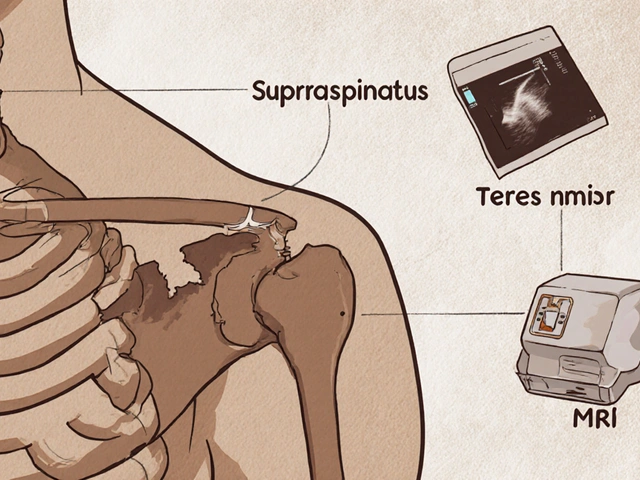Toradol vs. Pain Relievers Comparison Tool
Assess pain level: For short-term, severe pain (post-op, kidney stones), Toradol’s rapid, strong effect can be helpful—but only under medical supervision.
Check medical history: If you have a history of ulcers, chronic kidney disease, or are on blood thinners, avoid Toradol and most non-selective NSAIDs.
Consider duration: For lingering aches (muscle strain, arthritis), choose a longer-acting NSAID like naproxen or meloxicam.
Watch for drug interactions: Ketorolac can amplify the effect of anticoagulants. Ibuprofen and naproxen also interact but are generally less potent.
Factor in side-effect tolerance: If you're prone to GI upset, a COX-2-selective drug (celecoxib) or acetaminophen may be gentler on the stomach.
Key Takeaways
- Toradol is a powerful short‑term NSAID used for moderate to severe pain, but it carries higher GI and kidney risk than most OTC options.
- Ibuprofen and naproxen are milder NSAIDs suitable for many everyday aches with lower serious‑adverse‑event rates.
- Acetaminophen offers pain relief without anti‑inflammatory effects and is safe for stomach‑sensitive patients when dosed correctly.
- Celecoxib and meloxicam provide targeted COX‑2 inhibition, reducing GI irritation but may raise cardiovascular concerns.
- Opioids such as morphine are reserved for severe pain when NSAIDs are contraindicated, but they carry addiction and respiratory‑depression risks.
Toradol comparison helps you decide when a prescription‑only NSAID makes sense and which over‑the‑counter or prescription alternative fits your situation.
What is Toradol (Ketorolac) and how does it work?
When you first see Toradol is a potent non‑steroidal anti‑inflammatory drug (NSAID) whose active ingredient is ketorolac. It blocks the cyclooxygenase (COX) enzymes that produce prostaglandins, the chemicals that cause pain and inflammation.
Ketorolac is usually given as an injection or short oral course (often 5days or less). Its rapid onset-about 30minutes for IV use and 60minutes orally-makes it popular after surgery, dental procedures, or for acute kidney‑stone pain.
Because it hits COX‑1 and COX‑2 strongly, it also interferes with the protective lining of the stomach and reduces kidney blood flow. That’s why clinicians limit its use and avoid it in patients with ulcers, chronic kidney disease, or high bleeding risk.

Major alternatives to Toradol
Below are the most common pain‑relief drugs you’ll encounter. Each entry includes the drug’s typical dose, speed of relief, how long it lasts, and its headline safety concerns.
Ibuprofen is an over‑the‑counter NSAID that preferentially blocks COX‑2 at low doses
- Typical dose: 200‑400mg every 4‑6hours, max 1200mg OTC.
- Onset: 30‑60minutes.
- Duration: 4‑6hours.
- Main risks: stomach irritation, mild kidney impact, slight increase in heart‑attack risk at high doses.
Naproxen is a longer‑acting NSAID that also targets COX‑2 but stays in the system for up to 12hours
- Typical dose: 220‑250mg every 8‑12hours, max 660mg OTC.
- Onset: 45‑60minutes.
- Duration: 8‑12hours.
- Main risks: GI bleeding, kidney strain, cardiovascular events with chronic use.
Acetaminophen is a analgesic/antipyretic that works in the brain’s pain pathways without significant anti‑inflammatory action
- Typical dose: 500‑1000mg every 4‑6hours, max 3000mg (US) or 4000mg (EU) daily.
- Onset: 30‑45minutes.
- Duration: 4‑6hours.
- Main risks: liver toxicity at high doses or when combined with alcohol.
Celecoxib is a prescription‑only COX‑2‑selective NSAID that aims to spare the stomach lining
- Typical dose: 200mg once or twice daily.
- Onset: 60‑90minutes.
- Duration: 12‑24hours.
- Main risks: increased risk of heart attack or stroke, especially in patients with existing cardiovascular disease.
Diclofenac is an NSAID often used topically or orally for joint pain and inflammation
- Typical dose: 50‑75mg oral 2‑3 times daily, or 1‑3g topical gel per day.
- Onset: 30‑45minutes (oral), 1‑2hours (gel).
- Duration: 6‑8hours (oral), up to 12hours (gel).
- Main risks: GI ulceration, liver enzyme elevation, rare skin reactions.
Morphine is a strong opioid analgesic used for severe pain when NSAIDs are unsuitable
- Typical dose: 2‑10mg IV/IM every 2‑4hours, or oral 10‑30mg every 4‑6hours.
- Onset: 5‑10minutes (IV), 30‑60minutes (oral).
- Duration: 3‑4hours (IV), 4‑6hours (oral).
- Main risks: respiratory depression, constipation, tolerance, dependence, overdose.
Meloxicam is a prescription NSAID with a longer half‑life, often used for arthritis
- Typical dose: 7.5‑15mg once daily.
- Onset: 1‑2hours.
- Duration: 24hours.
- Main risks: GI bleeding, renal impairment, cardiovascular events similar to other NSAIDs.
Side‑by‑side comparison table
| Drug | Typical Dose | Onset | Duration | Main Risks |
|---|---|---|---|---|
| Toradol (Ketorolac) | 10‑30mg IV/IM, or 10‑20mg PO q6‑8h (max 5days) | 30min (IV), 60min (PO) | 4‑6h | GI bleeding, renal failure, platelet inhibition |
| Ibuprofen | 200‑400mg PO q4‑6h (max 1200mg OTC) | 30‑60min | 4‑6h | Stomach irritation, mild kidney impact |
| Naproxen | 220‑250mg PO q8‑12h (max 660mg OTC) | 45‑60min | 8‑12h | GI bleed, cardiovascular risk with chronic use |
| Acetaminophen | 500‑1000mg PO q4‑6h (max 3000‑4000mg) | 30‑45min | 4‑6h | Liver toxicity at high doses |
| Celecoxib | 200mg PO q12‑24h | 60‑90min | 12‑24h | Cardiovascular events, hypertension |
| Diclofenac | 50‑75mg PO q8‑12h or 1‑3g gel/day | 30‑45min (PO), 1‑2h (gel) | 6‑8h (PO), up to 12h (gel) | GI ulcer, liver enzyme rise |
| Morphine | 2‑10mg IV/IM q2‑4h or 10‑30mg PO q4‑6h | 5‑10min (IV), 30‑60min (PO) | 3‑4h (IV), 4‑6h (PO) | Respiratory depression, dependence |
| Meloxicam | 7.5‑15mg PO once daily | 1‑2h | 24h | GI bleed, renal impairment |
How to choose the right option for you
Think of drug selection as a balancing act between pain intensity, speed of relief, duration, and personal health factors.
- Assess pain level. For short‑term, severe pain (post‑op, kidney stones), Toradol’s rapid, strong effect can be a lifesaver-provided you’re under doctor supervision.
- Check medical history. If you have a history of ulcers, chronic kidney disease, or are on blood thinners, steer clear of Toradol and most non‑selective NSAIDs. Acetaminophen or a COX‑2‑selective agent may be safer.
- Consider duration. For lingering aches (muscle strain, arthritis), choose a longer‑acting NSAID like naproxen or meloxicam to avoid dosing every few hours.
- Watch for drug interactions. Ketorolac can amplify the effect of anticoagulants (warfarin, DOACs). Ibuprofen and naproxen also interact but are generally less potent in this regard.
- Factor in side‑effect tolerance. If you’re prone to GI upset, a COX‑2‑selective drug (celecoxib) or acetaminophen may be gentler on the stomach.
When in doubt, discuss with a pharmacist or prescriber. They can run a quick risk‑benefit check based on age, weight, renal function, and other meds.
Safety tips and common pitfalls
- Never exceed the recommended duration for Toradol. Five days is the hard ceiling for oral use; longer courses dramatically raise bleeding risk.
- Stay hydrated. NSAIDs, especially ketorolac, can reduce kidney perfusion. Drinking adequate fluids helps protect renal function.
- Avoid stacking NSAIDs. Taking ibuprofen with ketorolac offers no extra pain relief but doubles the chance of stomach bleeding.
- Mind the hepatitis warning with acetaminophen. Even small extra doses (e.g., from combination cold meds) can push you over the safe limit.
- Watch for signs of GI bleeding. Dark stools, melena, or sudden stomach pain after NSAID use require immediate medical attention.
Frequently Asked Questions
Can I take ibuprofen and Toradol together?
No. Both drugs block the same COX enzymes, so taking them together just raises the risk of stomach bleeding and kidney problems without providing extra pain relief. If you need additional pain control, talk to your doctor about switching rather than stacking.
Is Toradol safe for older adults?
Older adults are more prone to kidney impairment and GI bleeding. Because Toradol is a powerful non‑selective NSAID, clinicians usually avoid it in patients over 65 unless the benefit clearly outweighs the risk and the treatment period is short.
What makes celecoxib different from ibuprofen?
Celecoxib selectively inhibits COX‑2, the enzyme more responsible for pain and inflammation, while sparing COX‑1, which protects the stomach lining. That means less stomach upset, but it can raise the chance of heart problems, especially in people with existing cardiovascular disease.
Can I use acetaminophen if I’m allergic to NSAIDs?
Yes. Acetaminophen works through a different pathway, so an NSAID allergy (often due to COX inhibition) doesn’t affect it. Just watch the total daily dose to protect your liver.
When should I consider an opioid instead of an NSAID?
Opioids are reserved for severe, breakthrough pain when NSAIDs are contraindicated (e.g., active ulcers, severe renal disease) or have failed to control pain. They should be prescribed for the shortest possible time and under close monitoring.
By weighing how fast you need relief, how long you want it to last, and any personal health concerns, you can pick the right alternative to Toradol without compromising safety.






Phoebe Chico
October 9, 2025 AT 21:09Pain is a battlefield and our choices are the weapons we wield, so let us march with daring clarity into the realm of Toradol versus the common crowd of pain relievers. The fire of ketorolac burns bright and swift, a thunderbolt for the acute sufferer who cannot wait for the sluggish crawl of ibuprofen. Yet this blazing light casts shadows upon the stomach and kidneys, demanding respect from any citizen who dares to summon it. In our great nation we cherish both boldness and prudence, so we must weigh the fierce power against the gentle whisper of acetaminophen. The latter walks softly, sparing the gut, yet it cannot quell the inferno of post‑operative agony as Toradol can. Remember that the law of the land restricts ketorolac to a short, heroic campaign-no more than five days-lest the ally of bleeding rise. Our forefathers taught us that any excess, be it in liberty or dosage, can topple the strongest fortress. The quick onset, a mere half‑hour when injected, is a boon for those in the throes of kidney‑stone torment, a true testament to its might. But with great speed comes great responsibility, for the platelet inhibition can tip the scale toward dangerous hemorrhage. When we consider the elderly, we must not disregard the frailty of aging kidneys, for they are like rusted hinges on a mighty gate. The wise physician stands as a sentinel, ensuring the drug is wielded only when the pain is fierce and the time brief. In contrast, ibuprofen marches steadily, a reliable foot soldier, its risk moderate, its duration familiar. Naproxen, the long‑range archer, delivers relief across many hours, yet also bears the risk of heart‑related woes if used too long. Celecoxib, the COX‑2 specialist, spares the stomach but whispers the threat of cardiac storms. Each of these warriors has a place in the arsenal, and the commander in us must choose wisely, honoring both the spirit of American vigor and the sanctity of our bodies. So let us salute the science, respect the limits, and wield Toradol only when the battle calls for such an explosive force.
Larry Douglas
October 15, 2025 AT 16:02Toradol is a potent NSAID used for short‑term severe pain its rapid onset and high efficacy make it suitable for postoperative settings however its high risk profile especially gastrointestinal bleeding and renal impairment limit its use to a maximum of five days without proper monitoring
Michael Stevens
October 21, 2025 AT 10:56Hey everyone, just wanted to add that if you’re unsure which option fits your lifestyle, think about how often you’d need to take a dose. For most everyday aches, ibuprofen or naproxen are enough and they’re easy to get over the counter. If you have stomach issues, acetaminophen is a safer bet, but keep an eye on the total daily amount to protect your liver. Stay safe and talk to a pharmacist if you have any doubts!
Ann Campanella
October 27, 2025 AT 05:49Stop overcomplicating it-Toradol is for short bursts only.
Desiree Tan
November 2, 2025 AT 00:42Listen up-if you need fast, knockout‑level relief and you’re under a doctor’s watch, Toradol can be a game‑changer. But don’t let that power run wild; stick to the five‑day limit and keep hydrated to protect your kidneys.
Tammie Foote
November 7, 2025 AT 19:36Look, using a prescription‑only NSAID like Toradol when you’re not in a hospital setting is just reckless. Keep it classy and stick to OTC options unless your doc says otherwise.
Jason Ring
November 13, 2025 AT 14:29yo guys i think toradol can be real helpful when u have severe pain but u should really check with ur doc first
also dont mix it with other nsaids it can cause some nasty stomach bleeds
stay safe out there
Kelly Hale
November 19, 2025 AT 09:22In the grand tapestry of American resilience we must recognize that the very blood that pumps through our veins has been forged by the unyielding spirit of our forefathers, and so too must the choices we make about pain relief reflect that indomitable will. Toradol, with its thunderous strike against acute agony, stands as a testament to the power we wield when we demand immediate results. Yet the same fire that burns away pain can also scorch the very foundations of our health if we dare to abuse it-giant rivers of blood can flood the gut, and the kidneys, those stalwart guardians, can falter under the weight of relentless assault. Therefore, my fellow compatriots, let us not become slaves to convenience; let us honor the balance of strength and caution that built this nation. Use Toradol only under the vigilant eye of a physician, heed the five‑day limit, and remember that the true heroes are those who protect their bodies as fiercely as they protect their freedoms.